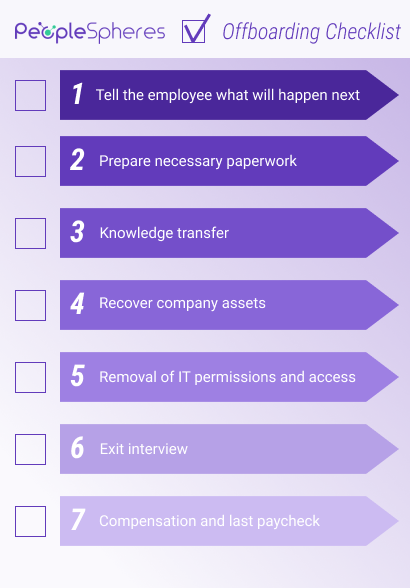-640x380.jpg)
How does your human resources department offboard employees? Did you know that offboarding employees is just as important as onboarding them?
If you feel like your offboarding process needs an upgrade, you have come to the right place. In this article, we will provide you with a complete guide for offboarding employees the right way.
Related articles:
Employee Farewell: Best Messages and Practices to Say Goodbye
Employee Offboarding Checklist for a Happy Company
What is Employee Offboarding?
Offboarding is defined as the process of formally separating employees from their job roles at a company, which is the last step in the employee lifecycle. This includes any necessary paperwork such as employee forms, exit interviews, recovering company assets, and more. There are multiple reasons why an employee leaves a company.
Data from a Gartner survey in 2022 reveals that only one in four employees are confident about their career in their organization, and three out of four people who are looking for a new role are interested in external positions.
Types of employment separation include:
- Firing
- Layoff
- Termination for: cause, mutual agreement, without prejudice, with prejudice
- Voluntary/involuntary termination
- Wrongful termination
- End of employment contract
- Resignation
- Retirement
The offboarding process is at the opposite pole of the onboarding process, which is at the start of the employee life cycle and includes integrating a new hire into a new job.
Why Offboarding Employees is Important
Offboarding is important for many reasons, including providing a clear path forward for the employee and manager ending the employment contract, while improving employee satisfaction and reducing security risk. Offboarding might be one of the most parts of the perception of one’s employee experience, as it is the last impression the company leaves the employee.
No matter if the employee is resigning voluntarily or getting laid off, you want the employee to leave with as high job satisfaction as possible. If employees leave with favorable impressions of the company and their co-workers, they are more likely to spread a positive message about the company culture.
Besides providing a competitive advantage in employer branding, when employees are leaving with favorable impressions, it also increases chances for reconnection in the future, which is especially important when it comes to top talent leaving your firm. The exit interview will give you an opportunity to assess whether it will be possible to rehire this employee in the future.
Offboarding employees properly provides a great opportunity to receive constructive feedback from them. They are more likely to provide transparent thoughts on their experience at the workplace when they are leaving it.
Employee Offboarding Checklist
To ensure that offboarding is done correctly, all HR teams should have established an employee offboarding checklist. The checklist should provide clear and concise guidelines on the offboarding procedures to ensure that the process is conducted as seamlessly as possible. Items to include guidelines on in the offboarding checklist includes:
- Tell the employee what will happen next
- Prepare necessary paperwork
- Knowledge transfer
- Recover company assets
- Removal of IT permissions and access
- Exit interview
- Compensation and last paycheck (include severance if applicable)

Fire an Employee
As mentioned earlier, there are different types of employment separation that lead to the deployment of offboarding. One of the types is firing.
In some circumstances, you might have no other choice than to fire an employee. This is not an easy process, and many employers dread the possibility of this happening. Having a clear and structured offboarding process will take some stress off the employers in this scenario.
Your HR team could also develop an employee handbook that indicates when it is legally allowed to fire an employee. The laws regarding the firing of employees differ from state to state, but there are some federal laws that protect employees. Unlawful reasons to fire an employee include:
- Discrimination
- Retaliation
- OSHA complaints
- Refusal to take lie detector test
- Alien status
Schedule HR Interview
Make sure to not deny the opportunity of an HR interview during the offboarding process, as it is one of the most valuable opportunities for HR professionals to receive transparent employee feedback. The interview conducted by the human resource team during one of the last days of work for the employee leaving, called the exit interview, can provide significant insights into aspects of your business processes such as onboarding, company culture, work environment, workplace relationships, the talent management process, and more.
Implementation of Feedback
As a part of the exit interview process, it is important that your HR department has procedures in place to implement the feedback on your company and its business processes. This should include analyzation of the information retrieved and ways to act on it actively and professionally. The feedback gained during the exit interview can lay a base for organizational improvement, anything from improved employee experience to a better understanding of efficient mentorship.
Questions to Ask when Offboarding Employees
There are many different types of questions that can be discussed during exit interviews. The questions depend on the situation and type of employment separation, but to give you a bigger picture, we list some examples of questions that can be discussed:
What Is Your Reason for Departure?
If the employee is leaving voluntarily, you could ask the reason for departure. The answer to the question can gain you valuable insight as to how to improve your employee retention rate.
What Could Have Been Done Better?
This question can be used for all situations, as all employees leaving might have useful information on how to improve your business processes or employee experience.
Describe the Organizational Culture
By asking the employee to describe the organizational culture, your HR management team can improve their understanding of the company culture, including organizational socialization, and ways to improve it for the other employees.
What Tools Should Be Implemented?
Depending on which job role the team member has, you want to ask what tools could be implemented. No matter the department, you can always ask the employees about the HR solutions used and which HR software they would recommend implementing.
Did the Company Provide the Necessary Training for This Job?
This question will give you insight into your employee onboarding program and your mentors. You can ask the employee if there is any onboarding software that would have improved the experience.
Offboarding Paperwork
Just like when new hires need to fill out a lot of paperwork during the onboarding process, so do employees that are leaving a company need to fill out paperwork during the offboarding process. Offboarding paperwork that should not be neglected includes successor documents, termination forms, and non-disclosure agreements.
Termination Forms
The termination letter is the official statement that states why the employment is being terminated. If it was the employee’s initiative to quit working, this will be stated in the termination form.
Non-Disclosure Agreement
The non-disclosure agreement is a written letter that signs by the employee to agree not to disclose any confidential information about the company, even after they left. Non-disclosure agreements reduce the security risks of an employee leaving a company.
Obtain Documents and Files They Worked On
Before the last day of work, you want to ensure that you have obtained documents and files that the employee worked on that are not uploaded to the cloud. If you miss this step, important work can get lost when your electronics are being wiped.
Preparation of Successor Documents
To streamline the process of a successor taking over the post of the employee leaving, prepare the documents of the successor as a part of the offboarding process. Then once you have found a successor, the documents are already prepared.
Take Security Measures when Offboarding Employees
Various steps need to be taken during the offboarding process to ensure that there are not going to be any security breaches after the employee leaves the company. This should be done no matter which employee is leaving your firm, as it should not have anything to do with trusting the intentions of the person. Security breaches can happen both intentionally and unintentionally, and if you do not take security steps during the offboarding process, all offboarded employees are a security risk.
Retrieve Company Items
If an employee has received company items, you want to retrieve these before his or her dismissal to avoid security breaches. If you have remote workers, you want to ensure that you are retrieving their items as well, as this can be easily forgotten about. Company-issued devices you should retrieve can be such as:
- Laptop
- Headset
- Mobile device
- Keys
- ID badge
- Uniforms
- Company credit cards
- And more…
To handle sensitive company items like laptops, a retrieval service can make the process smooth and secure. A laptop retrieval service might include prepaid shipping labels for remote employees or scheduled drop-offs for local staff. With a dedicated retrieval system, you can track laptop returns in real-time, lowering the risk of data breaches or unauthorized access. It also helps emphasize the importance of protecting company property during offboarding.
Restrict the Departing Employee’s Permissions
Employee accounts should never be deleted since they hold all historical employment data. However, it is crucial that the company restrict the access of the employee who left, to reduce the risk of a security breach. Access to remain on the employee account after offboarding includes items such as old paychecks and employee paperwork.
Redirection of Calls and Emails
When the employee leaves, you want to be sure that you are not missing any important calls and emails. Therefore, you want to automate a redirection of calls and emails to either a successor or an existing employee.
Utilization of Offboarding Software
Just as the utilization of software is crucial for efficient onboarding and training, it streamlines the offboarding process.
In an ISG survey regarding trends in technology and service deliverables, it was mentioned that onboarding and offboarding were one the ways that HR technology brought value.
To be successful in your offboarding procedures, offboarding software is necessary. PeopleSpheres is a unified platform that consolidates all your HR data and processes in one place, including offboarding. PeopleSpheres automates and simplifies your offboarding management through workflows and the ability to restrict permissions to all software at once.


-1-360x360.jpg)

-666x380.jpg)
